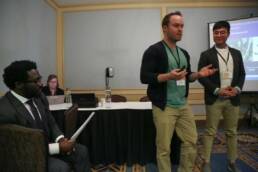The Lightning Talk format is very similar to a standard paper session or complete panel, only with more papers and shorter presentations. Six to eight papers are presented in a more abbreviated manner (six-minute maximum). After each presentation there will be two minutes of Q&A. Rather than using designated discussants, each participant reads the other papers and provides comments on one of them. At the conclusion of the presentations there is time for more extensive Q&A about any of the papers. The chair will help to keep presentations within the exact time limit, and each presenter will read the other papers and provide comments on one of them.
If you are participating virtually in a Lightning Talk session, you can view the virtual conference instructions here.

Frequently Asked Questions
Do I have to upload my research paper to the MPSA online conference program?
Yes. Uploading your research to the online conference program (instructions found here) allows fellow attendees to review your research in advance of your presentation.
What do I need to do to prepare for my Lightning Talk session?
In Lightning Talk sessions, presenters also function as discussants for one of the other papers being presented. Coordinate with your fellow panelists prior to the conference to determine which paper you will be providing comments on. Likewise, send your paper to the panelist who will be reading and commenting on yours. To view email addresses, click on a participant in the online program (you must be logged in to view email addresses).
What date/time is my Lightning Talk?
You can find the schedule for your Lightning Talk session in the online conference program. The online program is searchable by participant name, session time, and session format.
Where is my Lightning Talk located?
Lightning Talk sessions are held in standard conference rooms at the Palmer House (i.e., many of the same rooms that host paper sessions roundtables). The assigned room for your Lightning Talk will be available in the online conference program, the app, and in the print program at the conference.
How long should my presentation be?
No more than six minutes. Rehearse your presentation with a timer prior to the conference. Given the number of presenters, it is crucial that Lightning Talk presentations do not run beyond the allotted time. The chair will help to keep presentations within exact time limits.
Where can I access additional author resources?
Additional author resources and guidelines may be found here. Zoom tips can be found here. Information on the breakdown of session times, as well as session formats and role descriptions can be found here.
What do I bring to the conference?
Please bring your PowerPoint presentation to the conference on a removable USB-A flash drive. Your flash drive should be formatted for a Windows-based PC, not iOS.
What time should I arrive for my presentation?
Arrive at the conference room 10 minutes before your session begins.
What should I do if my discussant doesn’t show up for the session?
All discussants in the conference program have confirmed their participation and are expected to perform their roles. If there is an emergency that requires last-minute cancellation, discussants should make every effort to email the written comments that they would have given, so that the chair and panelists can read and discuss those comments during the session. In the event that the discussant(s) does not arrive for the session, and has not communicated their absence to any of the panelists, panelists should still present their papers and exchange feedback with one another. After the session, please inform the MPSA of the discussant’s absence by emailing the Conference Director (speelmon@mpsanet.org).
Looking for additional resources for the conference and/or your visit to Chicago?
View Author Guidelines, Chair Guidelines, Discussant Guidelines, Poster Guidelines and FAQs, Instructions for Virtual Attendees, and Tips for Using Zoom.
View Travel Resources, Onsite Details, A/V Details and Tech Support information, Local Dining options, Family Resources, and Health and Emergency Services locations and contact information. A Conference Guide can be found here.
